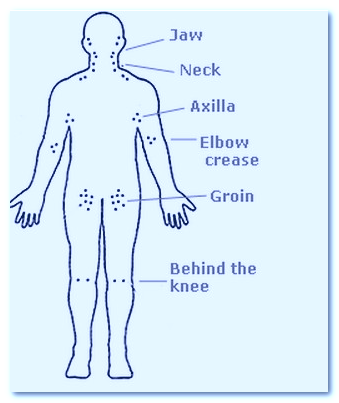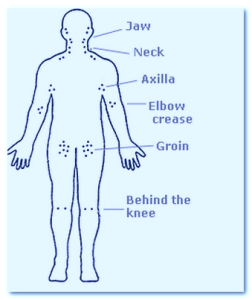Lymph nodes though often referred to lymph glands, are organs and not glands that spread throughout the body. These organs help in filtering out dead microbes like bacteria and virus as well as other dead tissue present in lymphatic fluid thereby eliminating them from the body. It is also in the lymph nodes where the white blood cells or lymphocytes, which help in immune system, spend much of their time.
When an activation of immune system occurs in body, the lymph nodes begin producing large amounts of lymphocytes, thereby causing these organs to swell. It is estimated that there are about 500 to 700 lymph nodes in the body located in different parts. Lymph node locations are spread throughout the body in specific areas. These organs are small and shaped like a bean. They occur in groups.
It is common for people to notice lymph nodes in neck where they help in fighting common illnesses, diseases, and infections. In locations of body where there are no lymph nodes because of something like lymphadenectomy, it is possible to have fluid collecting in the areas. Lymphadenectomy is a surgical procedure that removes one or more groups of these lymph nodes. This procedure is performed as part of management of cancer.
The groups of lymph nodes and their function
The body has groups of lymph nodes that are dedicated to maintain cells in the specific regions. Lymph fluid provides nourishment for cells in body while also getting rid of pathogens and debris as it moves to different lymph node groups.
One group of lymph nodes is the cervical group, which is located in the neck, head, jaw, and lymph nodes found deep along blood vessels. This group of nodes helps in filtering within areas that are located above shoulders. Another group is the mediastinal group, which is found in chest around the lungs, windpipe, and bronchi. This group of nodes circulates lymph fluid in the chest region.
Axillary group of nodes is located underside of arm and it circulates lymph fluid in areas of the breast, upper abdomen, and the chest. The Inguinal group of lymph nodes is found in groin area and it takes care of the lower limbs, genitals, and abdomen.
Lymph nodes found near nerve ending may cause pain and could affect the function of nerves in that area. This is because when the nodes swell, they will put pressure on the nerve endings. When you have lymph nodes of certain region or area swelling longer than some few days, it is good to consider seeking medical help.
Swelling of lymph nodes may indicate a disease, condition, or illnesses and when you have them swelling for extended time, there may be a condition that needs to be checked. It can help in preventing some serious medical condition that may remain undiagnosed.
Locations and number of lymph nodes in body
While there may be just few lymph node groups that you are familiar with such as those in the neck and under the arm or around the groin, the truth is that there are many locations where you find these nodes throughout the body. The nodes can add up to 700 in number. In the underarm area for instance, there are about 20 to 40 axillary lymph nodes. This means that lymph nodes are intensely spread and located in different parts of body.
The nodes start from head and extend all the way down to the knees where they fulfill their function of fighting pathogens, trapping debris, and at times but in rare cases, battling cancer cells. In all these locations, the lymph fluid moves as it feeds cells and filters the pathogens and debris.
Some nodes are near surface and others are found deeper in the tissue meaning that they wouldn’t be noticed even when they are swollen from an infection or disease. Each area will distribute, filter, and drain lymph fluid from different regions of body.
Swelling of lymph nodes
Swelling of lymph nodes may occur with or without your conscience. When the swelling occurs on those lymph nodes found near the surface, you may be able to touch and feel the swelling. However, when they occur deep in tissue or inner parts of body, it may not be possible to know that they are swollen.
Conditions like cold and flu tend to cause swelling of lymph nodes around the neck as they fight the viral or bacterial infection. The nodes will swell when they start to produce white blood cells known as lymphocytes and macrophages to help destroy pathogens like bacteria or virus.
At other times, the nodes can enlarge when they filter excess of what they are able to destroy, or they filter more of debris and dead tissue or pathogens than what can be carried out by the lymph fluid. Ailments such as skin infection, chicken pox, sinus infection, strep throat, or injury to face and scalp can cause the lymph nodes to enlarge.

